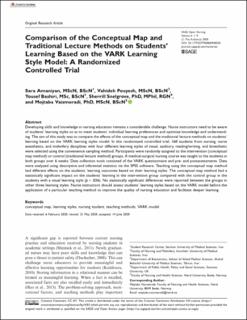| dc.contributor.author | Amaniyan, Sara | |
| dc.contributor.author | Pouyesh, Vahideh | |
| dc.contributor.author | Bashiri, Yousef | |
| dc.contributor.author | Snelgrove, Sherrill | |
| dc.contributor.author | Vaismoradi, Mojtaba | |
| dc.date.accessioned | 2020-07-20T08:29:23Z | |
| dc.date.available | 2020-07-20T08:29:23Z | |
| dc.date.created | 2020-07-08T14:17:34Z | |
| dc.date.issued | 2020 | |
| dc.identifier.citation | Amaniyan, S., Pouyesh, V., Bashiri, Y., Snelgrove, S. & Vaismoradi, M. (2020). Comparison of the conceptual map and traditional lecture methods on students' learning based on the VARK learning style model: A randomized controlled trial. Sage Open Nursing, 6. doi: | en_US |
| dc.identifier.issn | 2377-9608 | |
| dc.identifier.uri | https://hdl.handle.net/11250/2669690 | |
| dc.description.abstract | Developing skills and knowledge in nursing education remains a considerable challenge. Nurse instructors need to be aware of students’ learning styles so as to meet students’ individual learning preferences and optimize knowledge and understanding. The aim of this study was to compare the effects of the conceptual map and the traditional lecture methods on students’ learning based on the VARK learning styles model. In this randomized controlled trial, 160 students from nursing, nurse anesthetics, and midwifery disciplines with four different learning styles of visual, auditory, reading/writing, and kinesthetic were selected using the convenience sampling method. Participants were randomly assigned to the intervention (conceptual map method) or control (traditional lecture method) groups. A medical-surgical nursing course was taught to the students in both groups over 6 weeks. Data collection tools consisted of the VARK questionnaire and pre- and postassessments. Data were analyzed using descriptive and inferential statistics via the SPSS software. Teaching using the conceptual map method had different effects on the students’ learning outcomes based on their learning styles. The conceptual map method had a statistically significant impact on the students’ learning in the intervention group compared with the control group in the students with a visual learning style (p = .036). No statistically significant differences were reported between the groups in other three learning styles. Nurse instructors should assess students’ learning styles based on the VARK model before the application of a particular teaching method to improve the quality of nursing education and facilitate deeper learning. | en_US |
| dc.language.iso | eng | en_US |
| dc.publisher | SAGE Publishing | en_US |
| dc.rights | Navngivelse 4.0 Internasjonal | * |
| dc.rights.uri | http://creativecommons.org/licenses/by/4.0/deed.no | * |
| dc.title | Comparison of the conceptual map and traditional lecture methods on students' learning based on the VARK learning style model : A randomized controlled trial | en_US |
| dc.type | Peer reviewed | en_US |
| dc.type | Journal article | en_US |
| dc.description.version | publishedVersion | en_US |
| dc.rights.holder | © 2020 The Author(s) | en_US |
| dc.subject.nsi | VDP::Medisinske Fag: 700::Helsefag: 800::Sykepleievitenskap: 808 | en_US |
| dc.subject.nsi | VDP::Samfunnsvitenskap: 200::Pedagogiske fag: 280 | en_US |
| dc.source.pagenumber | 9 | en_US |
| dc.source.volume | 6 | en_US |
| dc.source.journal | Sage Open Nursing | en_US |
| dc.identifier.doi | 10.1177/2377960820940550 | |
| dc.identifier.cristin | 1818952 | |
| dc.description.localcode | Unit Licence Agreement | en_US |

